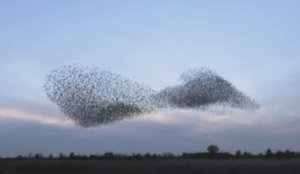Autumn brings out the birdwatcher in many of us. Migrant birds are moving all around the northern hemisphere, often in great flocks, making amazing spectacles.
Among them are the humble starlings. Cheeky, chatty little blue-black birds that go largely unnoticed for most of the year. A murmuration of starlings, as a flock is more poetically and correctly known, is mersmerising. The low murmurous ‘chat’ of the individual birds to each other fills the evening skies, as the birds themselves gradually group together in flight, looking for all the world like smoke, so closely do they fly, and so perfectly coordinated their movements around the sky.
Why do they do it? There are several reasons. The first is that the movement confuses predators. Hawks and falcons will pick off individual starlings. But in the group, flying together like that, it is much harder for the predator to pick out an individual and pursue them. Small fish do this too, to confuse sharks. The second reason is that they can exchange information, a critical strategy for survival. Finally, the practice brings them together over their roost, where they huddle close together for warmth. In other words, starlings are fundamentally stronger and better off together, and in constant communication.
But what’s really amazing about this aerobatic display is that starlings have no hierarchy. There is no dominant bird leading the flock. Instead, they seem to be in tune with each other to such an extent that any individual can act as leader and steer the flock in a new direction. This may be because they have seen a predator, or to take advantage of a new air current, or it may be simply because they want to do it. The point is that the individuals within the flock trust each other implicitly, and are prepared to move in response to each other.
Insights handled with trust and efficiency
Imagine a team that worked along similar principles. No waiting for a heirarchical leader to signoff changes. Instead, any individual who noticed the need for change would be in a position to start the necessary movement, and others would simply follow, until the next ‘leader’ stepped forward with new information or skills. It is where I see our own marketing team heading, and we are building interesting capabilities on the way.
First of all, it’s important to be aware of what’s going on around you. Starlings could not respond to each other if they were not so aware of their neighbours in the flock. In the same way, marketers cannot hope to respond to environmental changes if they are not constantly watching, monitoring and analysing their environment. Being part of SAS, we are naturally exposed to some of the more innovative thinking around data, analytics and insights.
Take for example the case for sustaining an analytics culture. Colin Powell elegantly described the investment in preparation and communication to meet challenges of transforming the State Department. In this case, the widespread introduction of analytics cascaded and was critical to the organisation’s ability to respond in the modern world. The required investment in preparation, skills and alignment for better communications is similar in marketing teams.
Sharing information effectively should also become a pervasive instinct. Stand underneath a murmuration, and the constant communication is apparent. Marketers too need to communicate constantly; with customers, sales, IT and each other. If everyone is to understand key values, support marketing strategies, and contribute to the desired business outcome, then they need the confidence of having the nest information at all times. This means building personal relationships at all levels, and developing trust within those relationships. This is tied to cultural and corporate values in an organisation, which needs to be sustained throughout the entire organisation for it to create the desired impact. It is something we at SAS believe we are building on.
Accept that there is no end
Perhaps one final lesson is the nature of a murmuration: constant, but in a perpetual state of flux. The birds were there last night, and will there again tomorrow, and indeed, next year. It may not be the same birds, or in exactly the same formations and patterns. Not to change is to be left behind, perhaps to be caught by a predator, or a competitor. In the same way, while we all like the comfort of milestones and firm targets, I see the unfolding digital economy bringing with in a constant stream of change.
If you are a fellow marketing leader, I’d be interested in hearing how you are preparing your team for the journey ahead. Most of us can see the need for transformation, and we will almost certainly need to pool our collective experiences to navigate safely.

